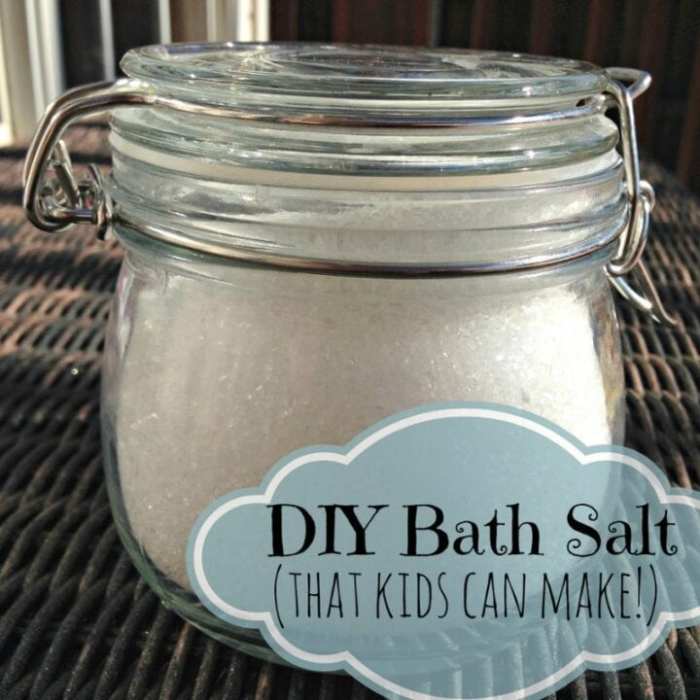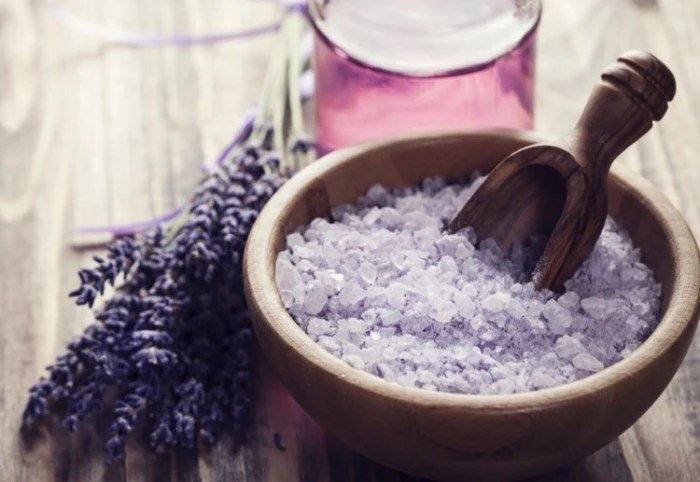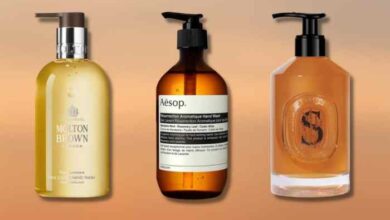
Make your own infused bath salts and transform your bathroom into a luxurious spa sanctuary. Imagine soaking in a warm bath infused with the calming scent of lavender, the invigorating aroma of citrus, or the soothing properties of chamomile.
These handcrafted bath salts are more than just a luxurious treat; they offer a range of benefits for your body and mind, from easing muscle tension to promoting restful sleep.
Infused bath salts are a simple yet effective way to elevate your self-care routine. You can customize them to suit your specific needs and preferences, making them a truly personal and enjoyable experience. Let’s dive into the world of DIY bath salts, exploring the essential ingredients, infusion techniques, and tips for creating your own personalized blends.
The Allure of Infused Bath Salts
There’s a reason why a warm bath is often considered the ultimate relaxation ritual. Adding infused bath salts to the mix takes this soothing experience to a whole new level, offering a multitude of benefits for both body and mind.
Infused bath salts are a luxurious way to indulge in self-care, combining the therapeutic properties of salts with the aromatic and healing qualities of natural ingredients.
Benefits of Infused Bath Salts
Infused bath salts are a treasure trove of benefits, ranging from stress relief to enhanced skin health. They provide a holistic approach to well-being, addressing both physical and mental aspects.
- Relaxation and Stress Relief:The warm water and the soothing scent of infused bath salts create a calming atmosphere, easing tension and promoting relaxation. The Epsom salts in many bath salts are known for their ability to draw out toxins and reduce muscle soreness, further contributing to stress relief.
- Skin Care:The minerals in bath salts, such as magnesium and potassium, can help to nourish and soften the skin. Certain infused bath salts, like those with lavender or chamomile, have anti-inflammatory properties that can soothe irritated skin and reduce redness.
- Improved Sleep:The relaxing effects of infused bath salts can help to promote restful sleep. The warmth of the water can help to relax muscles, while the calming scents of essential oils can ease the mind and prepare it for sleep.
History of Bath Salts
The use of bath salts dates back centuries, with evidence suggesting that ancient civilizations like the Egyptians and Romans incorporated salts into their bathing rituals.
- Ancient Egypt:Egyptians used salts for both medicinal and spiritual purposes. They believed that salts could purify the body and spirit, and they were often incorporated into religious ceremonies.
- Ancient Rome:The Romans were known for their elaborate bathhouses, where they used salts for relaxation and hygiene. They believed that the minerals in salts could improve circulation and skin health.
Cultural Significance of Bath Salts
Throughout history, bath salts have held cultural significance in various societies. They have been used for rituals, celebrations, and everyday hygiene practices.
- Traditional Chinese Medicine:In Traditional Chinese Medicine, bath salts are used to balance the flow of energy (Qi) in the body. They are believed to have specific properties that can address different health concerns.
- Japanese Onsen:In Japan, hot springs (onsen) are a popular form of relaxation and healing. Onsen water often contains high levels of minerals, including salts, which are believed to have therapeutic benefits.
Essential Ingredients for Infused Bath Salts

The foundation of your infused bath salt experience lies in the base ingredients. These salts not only add texture and buoyancy to your bath but also offer various therapeutic benefits. Choosing the right base ingredient is crucial for achieving your desired effects, whether it’s relaxation, muscle relief, or detoxification.
Bath Salt Base Ingredients
The choice of base ingredient is a crucial step in creating your infused bath salts. The most common bath salt base ingredients are Epsom salts, Himalayan pink salts, and sea salts. Each type possesses unique properties that cater to different needs.
- Epsom salts (Magnesium Sulfate):Known for their muscle-soothing properties, Epsom salts are widely used for easing aches, pains, and muscle tension. They also aid in drawing out toxins from the body, promoting detoxification. Magnesium, a key mineral in Epsom salts, is essential for over 300 bodily functions, including muscle and nerve function, blood sugar regulation, and blood pressure control.
Making your own infused bath salts is a fun and rewarding project, allowing you to customize your relaxation experience. The process is similar to crafting a beautiful and functional piece of furniture like a copper pipe child’s desk DIY , where you carefully select and combine materials to create something unique.
Just like that desk adds a touch of industrial chic to any room, your homemade bath salts can transform your bathroom into a spa-like sanctuary.
- Himalayan pink salts:Rich in trace minerals and electrolytes, Himalayan pink salts are believed to promote hydration and balance the body’s pH levels. Their unique pink hue is due to the presence of iron oxide, which adds a touch of visual appeal to your bath.
- Sea salts:Harvested from evaporated seawater, sea salts contain a variety of minerals, including magnesium, potassium, and calcium. These minerals are believed to support skin health, promote circulation, and offer a gentle exfoliating effect.
Choosing the Right Base Ingredient
The choice of base ingredient depends on your desired effects and personal preferences.
- For muscle relief and detoxification:Epsom salts are the ideal choice. Their high magnesium content helps relax muscles, relieve tension, and draw out toxins.
- For mineral replenishment and skin health:Himalayan pink salts or sea salts are excellent options. Their mineral content helps rehydrate the skin, balance pH levels, and provide a gentle exfoliating effect.
- For a luxurious and aromatic experience:Consider blending different base ingredients to create a unique blend that suits your needs. For instance, combining Epsom salts with Himalayan pink salts can provide both muscle relief and mineral benefits.
Infusing Bath Salts with Natural Ingredients
The beauty of infused bath salts lies in the ability to personalize your bathing experience with the power of nature. By incorporating natural ingredients, you can transform your bath into a therapeutic oasis, addressing specific needs and promoting overall well-being.
Exploring the Benefits of Natural Ingredients
Infusing bath salts with natural ingredients offers a myriad of benefits, ranging from soothing muscle aches and promoting relaxation to invigorating the senses and enhancing skin health. The choice of ingredients depends on your desired outcome, and each ingredient brings unique properties to the table.
A Guide to Natural Ingredients for Bath Salts, Make your own infused bath salts
This table provides a comprehensive overview of natural ingredients commonly used in bath salts, highlighting their properties and potential benefits. This information can guide you in selecting ingredients that align with your specific needs and preferences.
| Ingredient | Category | Properties and Benefits |
|---|---|---|
| Lavender | Herb | Known for its calming and relaxing properties. Promotes sleep, reduces anxiety, and soothes the mind. |
| Chamomile | Herb | Possesses anti-inflammatory and soothing properties. Relieves muscle tension, reduces stress, and promotes relaxation. |
| Rosemary | Herb | Stimulates circulation, improves cognitive function, and invigorates the senses. |
| Eucalyptus | Herb | Opens airways, relieves congestion, and has anti-inflammatory properties. |
| Rose petals | Flower | Known for their soothing and calming properties. Promotes relaxation and enhances mood. |
| Calendula | Flower | Possesses anti-inflammatory and skin-soothing properties. Helps heal minor cuts, burns, and skin irritations. |
| Lemon essential oil | Essential oil | Refreshing and invigorating. Helps uplift mood, promotes clarity, and cleanses the skin. |
| Tea tree essential oil | Essential oil | Antibacterial and antifungal properties. Effective for treating acne, athlete’s foot, and other skin conditions. |
| Orange peel | Dried fruit | Provides a refreshing and uplifting aroma. Contains antioxidants and promotes skin health. |
| Ginger | Dried root | Known for its warming and anti-inflammatory properties. Relieves muscle soreness and promotes circulation. |
Selecting and Preparing Natural Ingredients
When selecting natural ingredients for your bath salts, prioritize quality and freshness. Opt for organic ingredients whenever possible, as they are free from pesticides and other harmful chemicals. For herbs and flowers, choose those that are dried and free of mold or mildew.
For essential oils, select high-quality, therapeutic-grade oils from reputable suppliers.
Before adding ingredients to your bath salts, consider the following tips:
- Grind herbs and flowers:For optimal infusion, grind herbs and flowers into a fine powder using a mortar and pestle or a spice grinder.
- Dilute essential oils:Essential oils are potent, so it is essential to dilute them before adding them to your bath salts. A general guideline is to use 10-20 drops of essential oil per cup of bath salts.
- Store properly:Once your bath salts are infused, store them in an airtight container in a cool, dark place. This helps preserve their freshness and potency.
Methods for Infusing Bath Salts: Make Your Own Infused Bath Salts
Infusing bath salts with natural ingredients is an art that allows you to customize your bathing experience. There are several methods for infusing bath salts, each offering unique benefits and results. Let’s explore these methods and how to optimize them for different ingredients.
Soaking
Soaking is the most common method for infusing bath salts. It involves immersing the chosen ingredients in a base of bath salts, allowing the ingredients’ flavors and aromas to infuse the salts over time.This method is suitable for various ingredients, including dried herbs, flowers, and spices.
Here’s a step-by-step guide:
1. Gather your ingredients
Choose a base of Epsom salt, Himalayan salt, or sea salt. Select your desired ingredients, such as dried lavender flowers, chamomile, or rosemary.
2. Prepare the ingredients
Ensure the ingredients are dry and free of any debris. You can crush or grind them for faster infusion.
3. Combine the ingredients
In a glass jar, combine the bath salts with the chosen ingredients. The ratio depends on your preference, but a good starting point is 1 cup of bath salts to 1/4 cup of ingredients.
4. Soak the mixture
Seal the jar tightly and let it sit in a cool, dark place for at least 2 weeks. Shake the jar occasionally to ensure even infusion.
Making your own infused bath salts is a wonderful way to unwind after a long day. The process is simple, and you can customize the scent and ingredients to suit your mood. For inspiration, I often browse through fashion collections like the Tory Burch summer capsule collection for color palettes and textures that I can translate into my bath salts.
The vibrant hues and playful patterns of the collection always inspire me to create something unique and beautiful, just like a perfect summer day.
5. Strain and store
After the soaking period, strain the infused salts using a fine-mesh sieve. Store the infused bath salts in an airtight container in a cool, dry place.
Tip:For stronger infusions, use a higher ratio of ingredients to bath salts. You can also experiment with different soaking times, adjusting based on the ingredient’s potency.
Drying
Drying is a method that involves drying the chosen ingredients before adding them to the bath salts. This method is suitable for ingredients that are delicate or easily disintegrate in water, such as flowers, petals, and delicate herbs.Here’s a step-by-step guide:
1. Gather your ingredients
Choose your desired ingredients, such as dried rose petals, lavender, or chamomile.
2. Dry the ingredients
Dry the ingredients thoroughly using an oven on low heat or a food dehydrator. Alternatively, you can air dry them in a well-ventilated area.
3. Grind the ingredients
Once dry, grind the ingredients into a fine powder using a mortar and pestle or a spice grinder.
4. Combine with bath salts
Combine the powdered ingredients with the bath salts in a glass jar. The ratio depends on your preference.
Making your own infused bath salts is a fantastic way to create a personalized spa experience at home. You can experiment with different herbs, flowers, and essential oils to create unique blends that soothe your senses. And while you’re indulging in a relaxing bath, why not pair it with a glass of fine wine?
You can discover the latest best priced wines for your collection with bbx to enhance your self-care routine. Once you’ve found your perfect wine pairing, you can enjoy a truly luxurious and rejuvenating evening.
5. Store the infused salts
Store the infused bath salts in an airtight container in a cool, dry place.
Tip:To ensure the ingredients are completely dry, check for any moisture or dampness before grinding them. You can also experiment with different grinding levels, from coarse to fine, based on your preference.
Blending
Blending is a method that involves blending the chosen ingredients with a base of bath salts. This method is suitable for ingredients that are already in a powdered form, such as essential oils, spices, and clays.Here’s a step-by-step guide:
1. Gather your ingredients
Choose your desired ingredients, such as essential oils, cinnamon, or clay powder.
2. Combine the ingredients
In a blender, combine the bath salts with the chosen ingredients. The ratio depends on your preference, but a good starting point is 1 cup of bath salts to 1/4 cup of ingredients.
3. Blend the mixture
Blend the mixture until it is well combined and the ingredients are evenly distributed.
4. Store the infused salts
Store the infused bath salts in an airtight container in a cool, dry place.
Tip:For a more even distribution of essential oils, add a few drops of essential oil to a carrier oil, such as jojoba oil or sweet almond oil, before blending it with the bath salts.
Presentation and Storage of Infused Bath Salts
The final touch to your handcrafted bath salt creations is their presentation and storage. Not only does this ensure your bath salts remain fresh and potent, but it also allows you to express your creativity and create beautiful gifts.
Packaging and Presentation Ideas
The way you package your infused bath salts can significantly impact their visual appeal and perceived value. Consider these ideas to present your bath salts in a way that reflects their unique qualities:
- Glass Jars:Glass jars offer a clear view of the beautiful colors and textures of your bath salts. Choose jars with airtight lids to preserve freshness and prevent moisture absorption.
- Reusable Fabric Bags:For a more rustic and eco-friendly option, consider using reusable fabric bags made from cotton, linen, or muslin. These bags can be tied with a ribbon or twine for a charming touch.
- Paper Bags:Paper bags with a window are an excellent choice for showcasing the bath salts while providing a rustic and natural aesthetic. Add a decorative sticker or personalized tag for an extra touch.
- Gift Boxes:For a more elegant presentation, consider packaging your bath salts in small gift boxes. You can choose boxes made from cardboard, wood, or metal, depending on the overall style you desire.
- Layered Presentation:For a visually appealing display, create layers of different infused bath salts in a glass jar or bowl. You can use different colors, textures, and scents to create a stunning visual effect.
Storage Tips for Freshness and Potency
Proper storage is crucial for maintaining the freshness and potency of your infused bath salts. Here are some tips to ensure your creations remain at their best:
- Airtight Containers:Store your bath salts in airtight containers to prevent moisture absorption and oxidation. Glass jars with airtight lids are ideal for this purpose.
- Cool, Dry Place:Store your bath salts in a cool, dry place away from direct sunlight and heat. Avoid storing them in bathrooms, where humidity levels can be high.
- Labeling and Dating:Label your containers with the date of creation and the specific ingredients used. This will help you track their freshness and prevent using expired salts.
Personalized Labels and Gift Tags
Adding personalized labels and gift tags can elevate your bath salt creations into thoughtful gifts. Here are some ideas for creating unique and memorable labels:
- Handmade Tags:Create your own tags using cardstock, paper, or fabric. You can add handwritten messages, decorative elements, and even a small dried flower for a touch of whimsy.
- Printable Templates:Numerous free and paid printable templates are available online for creating custom labels and gift tags. You can personalize them with your chosen font, colors, and design elements.
- Digital Design:If you have design skills, you can create your own labels using graphic design software. This allows for greater control over the design and the inclusion of unique elements.
- Information on Labels:Include relevant information on your labels, such as the name of the bath salt blend, key ingredients, usage instructions, and a brief description of the scent and benefits.
Enjoying a Relaxing Bath with Infused Salts

A warm, fragrant bath with infused salts can be a truly rejuvenating experience. The ideal conditions for such a bath involve a combination of temperature, duration, and ambiance that promotes relaxation and well-being.
Setting the Ideal Bath Temperature
The optimal bath temperature for enjoying infused salts is between 98°F and 102°F (37°C and 39°C). This temperature range allows for comfortable relaxation without overheating or risking discomfort. A temperature too hot can lead to dehydration and dizziness, while a temperature too cold might not be conducive to relaxation.
Determining the Ideal Bath Duration
The duration of your bath with infused salts depends on your personal preference and the desired level of relaxation. A 15-20 minute soak is generally sufficient to experience the benefits of infused salts, but you can extend the duration up to 30 minutes if you wish.
It is important to listen to your body and exit the bath when you feel comfortable.
Creating a Relaxing Ambiance
To enhance the overall bathing experience, create a calming and soothing ambiance. Dim the lights, light scented candles, and play calming music to create a tranquil atmosphere. The scent of essential oils in the candles can complement the aromas of your infused salts, further enhancing the relaxation experience.
Enhancing the Bathing Experience with Aromatherapy
Aromatherapy plays a significant role in enhancing the relaxing benefits of an infused salt bath. The essential oils used in the infused salts can have various therapeutic properties, such as calming, energizing, or soothing. For example, lavender oil is known for its calming and relaxing effects, while peppermint oil can be invigorating and refreshing.
Maximizing the Benefits of Infused Bath Salts
To maximize the benefits of infused bath salts, consider the following tips:
- Add the salts to warm, not hot, water: This helps prevent the salts from losing their potency and ensures a more comfortable bathing experience.
- Soak for at least 15 minutes: This allows the salts to dissolve and release their beneficial properties.
- Hydrate before and after the bath: Infused salts can be dehydrating, so it is essential to drink plenty of water before and after your bath.
- Use a gentle, natural soap: This helps maintain the skin’s natural oils and prevent dryness.





